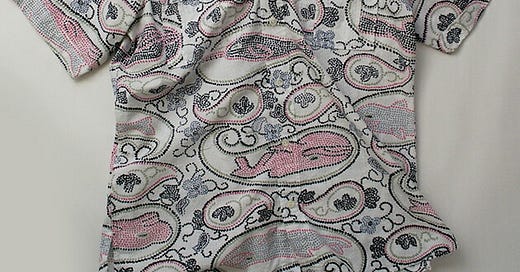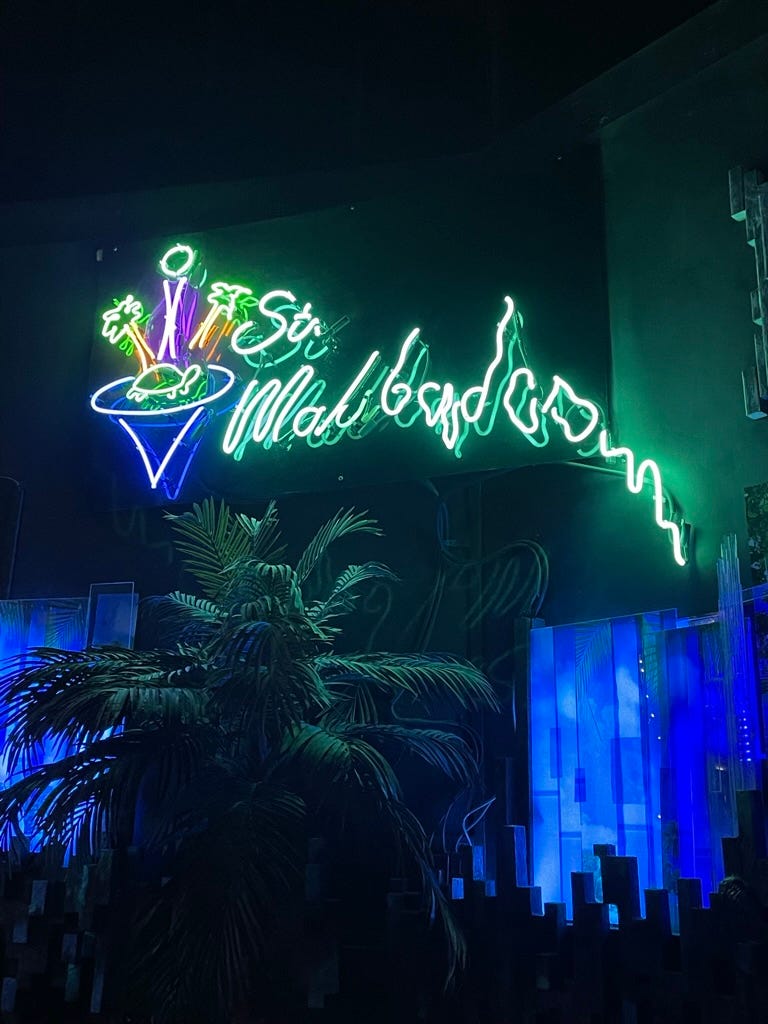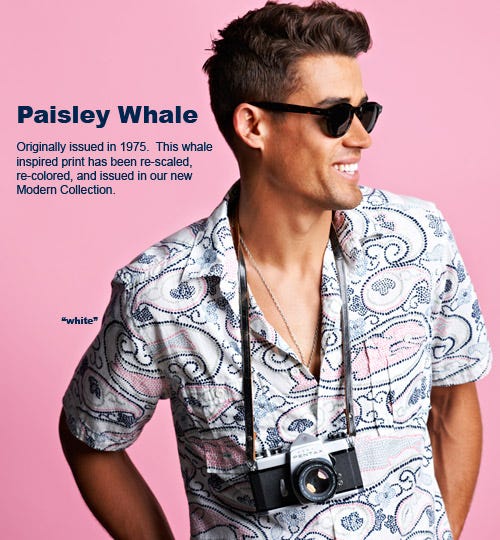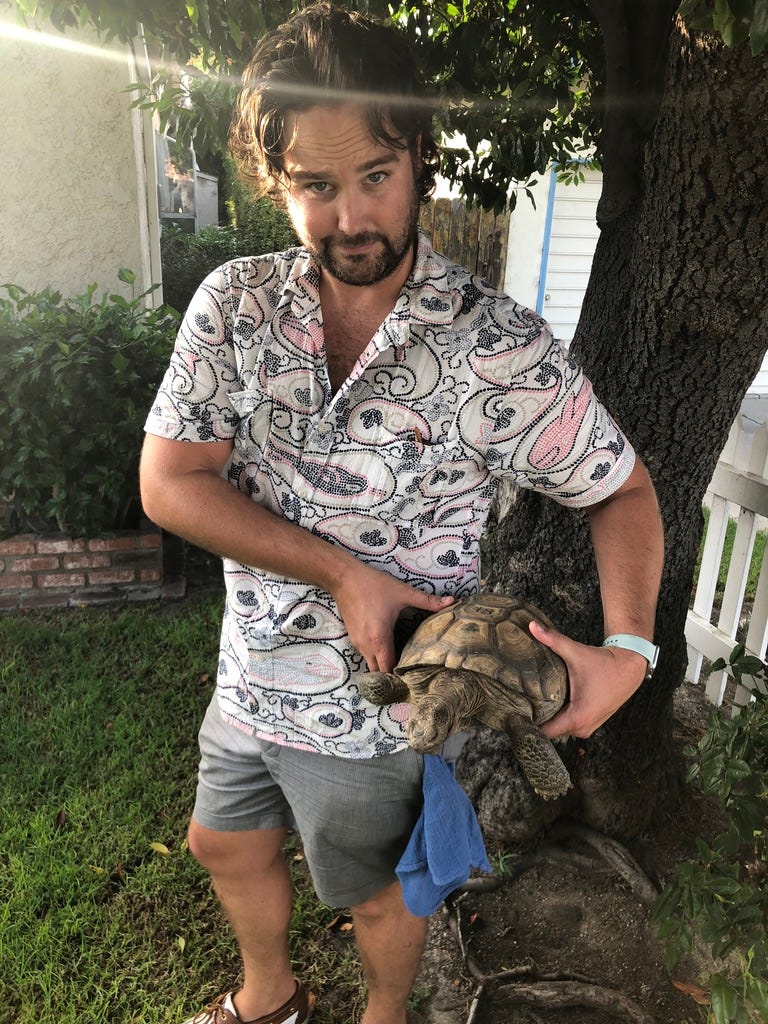Collection of One: My (Paisley) White Whale
"And of all these things the Albino whale was the symbol. Wonder ye then at the fiery hunt?"
Jimmy Buffet has finally escaped Margaritaville. While I can’t forgive his brand for taking over and desecrating the Palm Springs Riviera hotel1, I would have liked to share a seaplane with him.
I’m thankful to Jason Wilson and his Everyday Drinking substack for this fitting illumination of the less farcical aspects of Buffett’s work:
Likewise, there is an inevitable link between Buffett and Ernest Hemingway, and not just because of Key West. Along with Anthony Bourdain and Hunter S. Thompson, they likely make up the Mount Rushmore of hard-drinking, adventure-seeking, globe-trotting, macho escapism. But there is an inescapable, dark side to that escapism. Hemingway’s time in Key West and Cuba remains the period idealized by drinkers, but it’s also when he pissed away his talent on a bar stool.
At the weekend’s round of Labor Day gatherings, I ran into at least one person who had sagely and satirically donned his Reyn Spooner shirt in a kind of mourning gesture for Buffett. Reyn Spooner is the Aloha shirt for anyone that wants some heritage with their hibiscus (they have been making them in a wild array of motifs for a long time). My dad has one with the Los Angeles Dodgers running throughout (because he is loved by his sons).
My Reyn Spooner is an equally preposterous object: a swirling delirium of paisley whales.
This shirt was first released in 2013. I was finishing up law school at the time and could not afford to purchase a new one at full retail. And so it came and went from stores. Like Ahab’s white whale, this shirt stayed on my mind and I would periodically look for it, hoping to get one secondhand. It was that good.
I was finally able to get one from eBay in 2018. It’s never left my rotation and the joyful irreverence of this shirt really keeps me from needing anything else in the category (I have other printed shirts, but they don’t keep a place in the closet unless they are doing something very different from this one).
The details really make this shirt for me. It features two gusseted and bellowed utility pockets at the chest with button closures. They don’t really fit much, but they suggest that this shirt is somehow for utility (you most often seen bellows pockets on safari and other outdoor leaning jackets). They also remind me of the pockets on guayaberas, another positive association. Then there’s the print itself. Psychedelic and playful. We aren’t really concerned with what a whale looks like here, we just want the idea of whales. Lots of whales.
The detail that I most love, and couldn’t appreciate until I had it in hand, is that this is all happening on a white-on-white seersucker fabric. It’s so many things going on at once and it shouldn’t work. Going by description only, this shirt should be at Dan Flash’s.

And the giant comma-shaped swirls? They are paisley’s signature shape, the boteh (Persian for flower). Was the original pattern maker in the 70s struck by how similar in shape they are to a figurative whale? Is there a reason the whales can’t seem to agree on a plane of orientation and are all tumbling in their gravities? Only LSD knows. For a thoroughly excellent discussion of paisley as a pattern, I also need to recommend the Articles of Interest podcast from (is it too soon to start saying “the incomparable”?) Avery Trufelman. It’s an underappreciated, misunderstood and much maligned pattern. It comes to us from the ancient world, was worn by the Empress Josephine, counterfeited for mass adoption in Europe and is now mostly only seen bedecking the midsections of middle aged men in crisis.
Wearing a paisley shirt is a tricky proposition. The examples of them going right are rare. I wish I could remember where/how I encountered this insight originally, but the paisley shirt deserves some of the flak it gets for its increasingly unwavering association with middle aged men making a fashion mistake. I think this could be more common in the UK, where newly divorced men show up to the pub (or worse, the club) in them, but I lack the research and the cultural literacy to get beyond these initial guesses. I’m also no saint here. I’ve made mistakes with my own paisley shirts (long since donated) and seen the mistake out in the wild. I once had a bewildering exchange with a stupendously drunk stranger on the beach in Santa Monica. He was clad in a paisley shirt (magician vibes) and stingy brimmed Trilby (bookie vibes), and claimed repeatedly with pride to a group of us that he was wearing “all Ted Baker.” Indeed he was.2

But the pattern has nostalgic associations for many as well. My first run in with paisley was an Oleg Cassini tie handed down to me in high school as a cast off from my grandfather’s wardrobe.3 How Cassini went from dressing every movie star and Jacqueline Kennedy to providing ties for realtors in suburban Southern California deserves some pondering—but I am sure the payday from going mass and down market was very good.
So we’ve addressed the shirt’s physical aspects, but we can’t leave the metaphysical unaddressed. There’s something primeval going on with these figurative whales (comprised of many dots or small medallions like paleo pointillism), their paisley companions, and the way it’s all jammed onto this shirt.
For any discussion of the white whale shirt, it’s inevitable that I throw to Melville and Moby Dick. If you don’t want to read Moby Dick (and most people don’t), I would still recommend his chapter about whales (Chapter 32, “Cetology”) as good reading.4 It’s important that Melville’s whale was white—it adds to the terror.5 The history of whales terrorizing humans also goes well beyond the summer’s buzzy news about orcas scuttling our boats for fun, profit or fury.6 For me, all of this is going on in the background of this shirt. All the symbolic heft of the leviathans of our imagination, jammed frivolously onto an Aloha shirt.
In the scheme of things, five years wasn’t all that long to wait to get my white whale.
It’s not that I loved the Riviera hotel that much (a great spa, but I don’t much go in for anything associating itself so heavily with the Rat Pack), it’s more that its unceremonious conversion to a Margaritaville suggests an uncomfortable truth about the desert city I love. Some of Palm Spring’s kitsch isn’t really a high art/fun thing, it can actually be very tacky. Was similarly disturbed last year when I learned the Tommy Bahama bar/restaurant/apparel store in downtown Palm Springs (which I tell myself, less and less convincingly, that I am ironically patronizing when I go there) has won a “best mai tai” competition by a vote of the residents for several years running. Bootlegger, The Reef, and Tonga Hut and many others (probably the Parker too) surely make a better mai tai, but the city has spoken and chosen the one made by a dubious lifestyle brand.
I actually like Ted Baker in its proper lane (I have a much-loved pair of their navy ankle boots), but I will never understand this blacked out man confusing a slightly higher end mall brand with high fashion.
My grandfather’s wardrobe was a thing of wonder to me and I hope to leave something similar to my children. Pink and green sport coats? Check. Botany 500 trousers in lavender or cream herringbone? Also check. I didn’t realize this until just now, but I was like a suburban, clownish Lako Elkann, reinterpreting and making use of this menagerie of clothing from my grandfather. My grandfather Jim the Realtor is also no Gianni Agnelli, but he has an eye for clothes and many other things that mostly transcends his Orange County roots.
Melville spends a whole chapter on the importance of whiteness in his imagined whale (Chapter 42, “The Whiteness of the Whale”).
Moby Dick was inspired by a true story. The 6th century Byzantines were harassed by a commerce raiding whale they called Porphyrios, which possibly meant something in our modern doge-speak like “big purple boy.”








